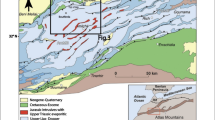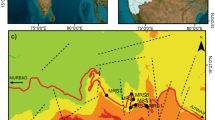Abstract
The Longchi area with the city of Dujiangyan, in the Sichuan province of China, is composed of Permian stone and diorites and Triassic sandstones and mudstones intercalated with slates. An abundance of loose co-seismic materials were present on the slopes after the May 12, 2008 Wenchuan earthquake, which in later years served as source material for rainfall-induced debris flows or shallow landslides. A total of 48 debris flows, all triggered by heavy rainfall on 13th August 2010, are described in this paper. Field investigation, supported by remote sensing image interpretation, was conducted to interpret the co-seismic landslides in the debris flow gullies. Specific characteristics of the study area such as slope, aspect, elevation, channel gradient, lithology, and gully density were selected for the evaluation of debris flow susceptibility. A score was given to all the debris flow gullies based on the probability of debris flow occurrence for the selected factors. In order to get the contribution of the different factors, principal component analyses were applied. A comprehensive score was obtained for the 48 debris flow gullies which enabled us to make a susceptibility map for debris flows with three classes. Twenty-two gullies have a high susceptibility, twenty gullies show a moderate susceptibility and six gullies have a low susceptibility for debris flows.
Similar content being viewed by others
References
Alexander D (1989) Urban landslides. Progress in Physical Geography 13: 157–191.
Bai XH, Ma JH (2008) Geographical information system for landslides hazard evaluation. Gansu Geology 17(4): 72–75. (In Chinese)
Caine N (1980) The rainfall intensity duration control of shallow landslides and debris flows. Physical Geography 62(1–2): 23–27.
Chang FJ, Chiang YM, Lee WS (2009) Investigating the impact of the Chi-Chi earthquake on the occurrence of debris flows using artificial neural networks. Hydrol Process 23: 2728–2736.
Chen H, Dadson S, Chi YG (2006) Recent rainfall induced landslides and debris flow in northern Taiwan. Geomorphology 77: 112–125. DOI:10.1016/j.geomorph.2006.01.002.
Dai FC, Xu C, Yao X, et al. (2011) Spatial distribution of landslides triggered by the 2008 Ms 8.0 Wenchuan earthquakes, China. Journal of Asian Earth Sciences 40(4): 883–895. DOI: 10.1016/j.jseaes.2010.04.010.
Dong JJ, Lee CT, Tung YH, et al. (2009) The role of the sediment budget in understanding debris flow susceptibility. Earth Surface Processes and Landforms 34: 1612–1624. DOI: 10.1002/esp.1850.
Guzzetti F, Peruccacci S, Rossi M, Stark C (2008) The rainfall intensity-duration control of shallow landslides and debris flows: an update. Landslides 5: 3–17. DOI: 10.1007/s10346-007-0112-1.
Hürlimann M, Copons R, Altimir J (2006) Detailed debris on hazard assessment in Andorra: a multidisciplinary approach. Geomorphology 78: 359–372. DOI: 10.1016/j.geomorph.2006.02.003.
Huang RQ, Li WL (2009) Analysis of the geo-hazards triggered by the 12 May 2008 Wenchuan Earthquake, china. Bull of Engineering Geology and the Environment 68:363–371. DOI: 10.1007/s11629-013-2471-5.
Iswar D, Alfred S, Norman K, Vinay K (2012) Landslide susceptibility mapping along road corridors in the Indian Himalayas using Bayesian logistic regression models. Geomorphology 179:116–125. DOI: 10.1016/j.geomorph.2012.08.004.
Iverson RM, Reid ME (1997) Debris flow mobilization from landslides. Annual Review of Earth and Planetary Sciences 25: 85–138. DOI: 10.1146/annurev.earth.25.1.85.
Jibson RW (1989) Debris flow in southern Porto Rico. Geological Society of America 236: 29–55.
Khattak GA, Owen LA, Kamp U, Harp EL (2010) Evolution of earthquake triggered landslides in the Kashmir Himalaya, northern Pakistan. Geomorphology 115: 102–108. DOI: 10.1016/j.geomorph.2009.09.035.
Koi T, Hotta N, Ishigaki I, et al. (2008) Prolonged impact of earthquake-induced landslides on sediment yield in a mountain watershed, the Tanzawa region, Japan. Geomorphology 101: 692–702. DOI: 10.1016/j.geomorph.2008.03.007.
Lan HX, Zhou CH, Wang LJ, et al. (2004) Landslide hazard spatial analysis and prediction using GIS in the Xiaojiang watershed, Yunnan, China. Engineering Geology 76: 109–128. DOI: 10.1016/j.enggeo.2004.06.009
Li H, Fu X, Vander Woerd J, et al. (2008) Co-seismic surface rupture and dextral-slip oblique thrusting of the Ms 8.0 Wenchuan earthquake. Acta Geologica Sinica 82(12): 1623–1643.
Liu XL (1988) Study on the judge of debris flow dangerous degree. Journal of Catastrophology 3(3): 10–15. (In Chinese)
Shieh CL, Chen YS, Tsai YJ, Wu JH (2009) Variability in rainfall threshold for debris flow after the Chi-Chi Earthquake in central Taiwan, China. International Journal of Sediment Research 24(2): 177–188.
Takahashi T (1981) Estimation of potential debris flows and their hazardous zones. Natural disasters 3: 57–89.
Tang C, Zhu J, Li WL (2009) Rainfall triggered debris flows following the Wenchuan earthquake. Bulletin of Engineering Geology and the Environment 68: 187–194. DOI: 10.1007/s10064-009-0201-6
Tang C, Van Asch TWJ, Chang M, et al. (2011a) Catastrophic Debris flows on 13 August 2010 in the Qingping area, southwestern China: The combined effects of a strong earthquake and subsequent rainstorms. Geomorphology 139: 559–576. DOI: 10.1016/j.geomorph.2011.12.021.
Tang C, Zhu J, Ding J, et al. (2011b) Catastrophic debris flows triggered by a 14 August 2010 rainfall at the epicentre of the Wenchuan earthquake. Landslide 8: 485–497. DOI: 10.1016/j.geomorph.2011.12.021.
Tang C, Zhu J, Chang M, Ding J (2011c) An empirical-statistical model for predicting debris-flow runout zones in the Wenchuan earthquake area. Quaternary International 250: 63–73. DOI: 10.1016/j.quaint.2010.11.020.
Van Western CJ, Castellanos E, Kuriankose SL (2008) spatial data for landslide susceptibility, hazard, and vulnerability assessment: An overview. Engineering Geology 102(3–4):112–131. DOI: 10.1016/j.enggeo.2008.03.010.
Wei CL (2008) Landslides risk assessment Based on GIS for Wuhan. Chongqing: Southwest University. (In Chinese with English abstract)
Wei YM, Xie YY, Wu YQ (1998) Applications of relativity analysis method and fuzzy synthetical assessment method in classification of dangerous degree of debris flow. Journal of Natural Disasters 7(2): 109–117. (In Chinese)
Wieczorek GF (1987) Effect of rainfall intensity and duration on debris flows in central Santa Cruz Mountains, California. In: Costa JE, Wieczorek GF (Eds.) Debris flows/avalanches, process, recognition and mitigation, Geological Society of America, Reviews in Engineering Geology 93–104.
Xie H, Zhong DL, Jiao Z (2009) Debris Flow in Wenchuan Quake-hit Area in 2008. Journal of Mountain Science 27(4): 501–509. (In Chinese)
Xu C, Xu XW, Dai FC, Arun KS (2012) Comparison of different models for susceptibility mapping of earthquake triggered landslides related with the 2008 Wenchuan earthquake in China. Computers & Geosciences 46: 317–329. DOI: 10.1016/j.cageo.2012.01.002.
Xu Q (2010) The 13 August 2010 catastrophic debris flows in Sichuan province: characteristics, genetic mechanism and suggestions. Journal of Engineering Geology 18(5): 596–608. (In Chinese)
Zhai P, Zhang XB, Wan H, Pan XH (2005) Trends in total precipitation and frequency of daily precipitation extremes over China. Journal of Climate 18: 1096–1108. DOI: 10.1175/JCLI-3318.1.
Zhou JW, Cui P, Fang H (2013a) Dynamic process analysis for the formation of Yangjiagou landslide dammed lake triggered by the Wenchuan earthquake, China. Landslides 10:331–342. DOI: 10.1007/s10346-013-0387-3.
Zhou W, Tang C (2013b) Rainfall thresholds for debris flow initiation in the Wenchuan earthquake stricken area, southwestern China. Landslides: online. DOI: 10.1007/s10346-013-0421-5.
Author information
Authors and Affiliations
Corresponding author
Rights and permissions
About this article
Cite this article
Chang, M., Tang, C., Zhang, Dd. et al. Debris flow susceptibility assessment using a probabilistic approach: A case study in the Longchi area, Sichuan province, China. J. Mt. Sci. 11, 1001–1014 (2014). https://doi.org/10.1007/s11629-013-2747-9
Received:
Accepted:
Published:
Issue Date:
DOI: https://doi.org/10.1007/s11629-013-2747-9




